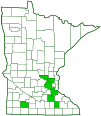white-winged march fly
(Bibio albipennis)
Conservation • Description • Habitat • Ecology • Distribution • Taxonomy
|
|
||||||||||||||
Description |
Bibio is a large genus of march flies with about 200 species worldwide. The most common and widespread of these is Bibio albipennis. White-winged march fly is a common, early season, small to medium-sized fly. It occurs throughout the United States but is mostly absent in the southeast and in the Great Plains. In Canada it occurs in the southern regions of Quebec, Ontario, Alberta, and British Columbia. It also occurs on the Baja Peninsula in Mexico. In the U.S. it is most common in the northeast and west of the Rocky Mountains. It is not common in Minnesota. Adults are found in May in Minnesota. They are gregarious and usually occur in large swarms. The larvae feed on decaying organic material and on the roots of grasses and other plants. They are found on manure and leaf litter in forests, meadows, and pastures. White-winged march fly is moderately large for the genus Bibio, but small to medium-sized for a fly (order Diptera). The size of adults is extremely variable. The wing length ranges from 3 ⁄16″ to ⅜″ (4.7 to 9 mm), but on most individuals it is at least 5⁄16″ (7.5 mm). Males and females look very different. On the male, the head is compressed from top to bottom. When viewed from above it is oval and slightly wider than long. There are two large compound eyes on the sides of the head and three small simple eyes (ocelli) in a triangle on top of the head. The compound eyes are large and meet at the top of the head. On the female, they are round or oval, and they are broadly separated at the top of the head. The antennae are short and stout, they have 9 segments, and they rise low on the face. The body is stout, entirely black, shiny, and moderately to densely covered with pale, gray to yellowish-gray hair. The density of the hair is extremely variable, both geographically and within populations. Western populations tend to be more densely hairy. On the male, the abdomen is elongated and is gradually tapered to the end. On the female it is much stouter. The wings are clear on the male, slightly tinted brown on the female. They may appear white from reflected light at a certain angle. The veins on the front part of each wing are brown, those on the back part are clear or slightly colored. The thickened part of the costa (C) vein ends near the wing tip. The radial sector (RS) vein is unbranched. The media (M) vein has three branches. The RS and M1+2 veins are separated for their entire length; they do not join for a short distance. The radio-medial (r-m) crossvein is present but very short. On the front pair of legs, the fourth segment (tibia) has a pair of large spurs at the tip. The inner spur is short, no more than half as long as the outer spur. The end part of each leg (tarsus), corresponding to the foot, has 5 segments. The end segment has a pair of claws at the tip, and there is a pad (pulvillus) between the claws. |
Size |
Wing length: 3 ⁄16″ to ⅜″ (4.7 to 9 mm) |
Similar Species |
Habitat |
Forests, meadows, and pastures |
Ecology |
Season |
May in Minnesota, April to June elsewhere |
Behavior |
|
Life Cycle |
|
Larva Food |
decaying organic material, roots of grasses and other plants |
Adult Food |
|
Distribution |
||
|
Sources |
|
| 5/20/2024 | ||
Occurrence |
||
|
||
Taxonomy |
|
Order |
|
Suborder |
Nematocera |
Infraorder |
Bibionomorpha (gnats and allies) |
Superfamily |
Sciaroidea (fungus gnats and gall midges) |
Family |
Bibionidae (march flies) |
Subfamily |
Bibioninae |
Tribe |
Bibionini |
Genus |
Bibio |
Subordinate Taxa |
|
|
|
Synonyms |
|
|
|
Common Names |
|
white-winged march fly |
|
Glossary
Ocellus
Simple eye; an eye with a single lens. Plural: ocelli.
Tarsus
On insects, the last two to five subdivisions of the leg, attached to the tibia; the foot. On spiders, the last segment of the leg. Plural: tarsi.
Tibia
The fourth segment of an insect leg, after the femur and before the tarsus (foot). The fifth segment of a spider leg or palp. Plural: tibiae.
Visitor Photos |
||
Share your photo of this insect. |
||
This button not working for you? |
||
Greg Watson |
||
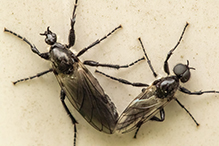 |
|
|
Babette Kis |
||
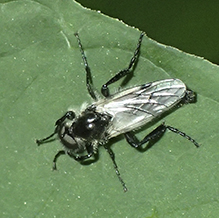 |
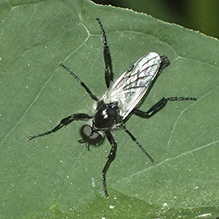 |
|
Bibio albipennis White-winged March fly Bibio albipennis, white-winged March fly, photographed at Barnes Prairie, Racine Co., WI on May 29, 2023. |
||
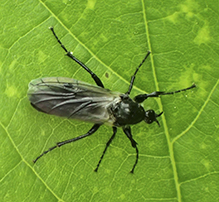 |
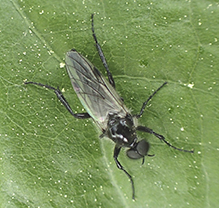 |
|
| Bibio albipennis female May 24, 2021 Barnes Prairie near the hedgerow, Racine Co., WI | Bibio albipennis male, Barnes Prairie by hedgerow, May 20, 2021 |
|
MinnesotaSeasons.com Photos |
||
|
||
|
||

Slideshows |
|

Visitor Videos |
||
Share your video of this insect. |
||
This button not working for you? |
||
|
Other Videos |
||
|

Visitor Sightings |
||
Report a sighting of this insect. |
||
This button not working for you? |
||
Greg Watson |
Location: La Crescent, MN |
 |
| Babette Kis 5/29/2021 |
Location: Barnes Prairie, Racine Co., Wisconsin Bibio albipennis, white-winged March fly, photographed at Barnes Prairie, Racine Co., WI on May 29, 2023. |
 |
| Babette Kis 5/24/2021 |
Location: Barnes Prairie, Racine Co., Wisconsin Bibio albipennis female May 24, 2021 Barnes Prairie near the hedgerow, Racine Co., WI |
 |
| Babette Kis 5/20/2021 |
Location: Barnes Prairie, Racine Co., Wisconsin Bibio albipennis male, Barnes Prairie by hedgerow, May 20, 2021 |
 |
MinnesotaSeasons.com Sightings |
||
|

Created: 8/30/2023 Last Updated: © MinnesotaSeasons.com. All rights reserved. |
